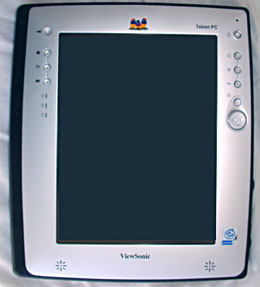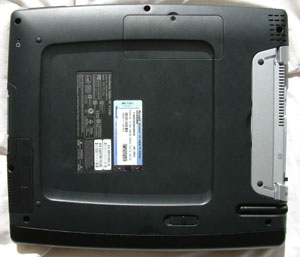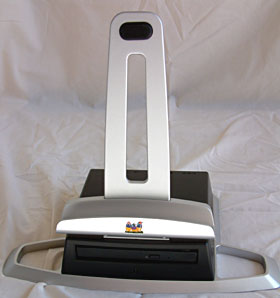|
|||||||||
Advertisement |
ViewSonic PC V1100 Tablet PC, Windows XP Tablet Edition Notebook- by Lisa Gade, Editor in Chief. Posted Feb. 2003 If you want to read a brief intro to Windows XP Tablet Edition notebook features and specs, click here. Tablet PCs running Windows XP Tablet Edition come in two flavors: standard notebook designs with keyboards and true tablets. The ViewSonic Tablet PC is among the latter. The ViewSonic is the only XP tablet on the market designed primarily to be used in portrait mode, though landscape mode is supported. It's buttons are on the long side of the computer, while other tablets have the buttons on the short side, and the optional docking station holds the unit in portait orientation. It weighs 3.4 lbs.
First Impressions Out of the box, the ViewSonic is attractive in its silver and black plastic finish. It's not quite as chic or high quality looking as the Gateway Tablet PC, but looks aren't everything and it does cost several hundred dollars less than the Gateway. The front of the unit has buttons for most commonly needed tasks, such as screen rotation, closing windows, openning the Windows Start Menu, locking the unit, navigation and launching apps. This makes life without a keyboard much easier. As can be said of all tablet PCs, if not of all notebooks in general, the docking station is made of plastic. It's got an attractive easel-like design, and provides you with a CDROM drive and additional USB ports, along with a power connector. The docking station is a $299 optional accessory, and includes a spare charger. Horsepower and What's Inside The unit has a Mobile Pentium III running at 866 MHz, a pretty common speed and processor for current tablets. It comes with 256 megs of SDRAM expandable to 768 megs, a 20 gig hard drive (attached to an Intel Ultra ATA controller), built-in WiFi 802.11b using the same Intel Pro Wireless 2011b chipset also used in tier 1 CF WiFi cards, and a standard RJ45 Ethernet port along with 1 type II PCMCIA slot and 1 type II CF slot. You'll find a good range of ports on the computer, including 2 USB 1.1 ports, Firewire (4 pin non-powered), VGA, audio in and out, a 56k modem and the Ethernet port. |
Questions?
Comments?
|
Battery Life, Screen, Sound, Software The battery has lasted about 4 hours per charge so far with WiFi turned on. For a notebook of this size and speed, the battery life is good. The ViewSonic has a generous 3900 mAh Lithium Ion battery, yet it charges in under 2 hours from empty to full. The screen is capable of displaying 16 million colors at 1024 x 768 resolution. Its 10.4" display is quite sharp for a tablet. As with all XP Tablets, the surface is durable and is designed to allow you to rest your hand on the screen without showing grease marks. Tablet PC displays can't compare to traditional notebook LCDs when it comes to sharpness, brightness and viewing angle because they aren't just displays but also digitizers, and the cost of a brighter, sharper display would be prohibitive. That said, the ViewSonic ties with the Gateway Tablet PC for having the sharpest tablet display and looks (relatively) good. It is not the brightest tablet display, however. Just as Microsoft promised, every commercial software package we've installed has worked fine. As part of my standard set of test applications, I installed and used Office 2000 Pro, Adobe Photoshop 7, Dreamweaver MX and several other apps without a problem. Using Photoshop and Painter is a dream on XP Tablet PCs. Drawing and making lasso selections is a much more satisfying and intuitive experience when you're using a pen directly on the screen rather than an accessory digitizer. I can't say enough about how wonderfully it works. You can select the text tool in Photoshop, then use voice dictation to speak your text! If you're a serious designer working with print media files, keep in mind that the processor isn't fast compared to standard notebooks and desktops, and applying filters and transforms on large files (over 30 megs) will be slower compared to current state of the art traditional notebooks. Docking Station and Included Peripherals The Docking Station is made of plastic, but it has a good sturdy feel and enough weight to ensure stability on your desk. It holds the computer in portrait mode, and has a futuristic, if not artsy look. It has 3 USB ports on the rear along with power, 1 RJ45 Ethernet port, a VGA out. As you can see from the photo, it has a tray-loading CDROM drive facing front. The CDROM read CDs at 24x and it is only a CD drive-- it can't play DVDs or record onto CD recordable media. For the $299 price tag I would've liked to have seen a DVD/CDRW drive rather than a basic CDROM drive. The included USB keyboard is an 86 key notebook-sized unit with an embedded numeric keypad. Its silver finish matches the silver surround on the computer. Though it lacks dedicated number keys, it does have page up/down and 4 arrow keys for navigating documents. The keyboard is light, weighing in at about 20 ounces. The Pen and Voice Experience: Trying Out Those Tablet PC Features! Since handwriting recognition, digital ink technology, voice dictation and voice command are built into the operating system, don't expect much variation between competing brands and models. Machines with faster processors will translate handwriting into text more quickly, and might also do a better job of voice recognition. Many of the first generation machines share the same Mobile Pentium III running at 866 MHz used in the Gateway Tablet PC. The Toshiba Tablet is one of the few exceptions, running at 1.3 GHz. Also, a better built-in mic can help improve voice recognition, but you're really going to need a good quality headset mic if you want to successfully use voice dictation. Why? A good headset mic is always going to be of better quality compared to a built-in mic, and you won't have to worry as much about ambient noise. When you boot up your ViewSonic, you'll be greeted by an excellent tutorial that will walk you through using digital ink, handwriting recognition, voice commands and voice dictation.It really does tell you everything you need to know in a succinct manner. You'll even watch a few Windows Media Player movies in the process of learning about the Tablet PC features. And for us lefties out there, you'll be happy to know that you can tell it whether you're a southpaw or rightie. You can flip the screen in portrait mode so that the handgrip and button strip are on the left rather than the right. The tutorial and lefty-friendly features are part of the Windows XP Tablet OS feature set. |
Above: back side of the ViewSonic PC V1100
The optional docking station has a 24x CDROM drive, 3 USB ports, a VGA port, an Ethernet RJ45 port and a power jack. |
|
The Pen and Voice Experience: Trying Out Those Tablet PC Features! Since handwriting recognition, digital ink technology, voice dictation and voice command are built into the operating system, don't expect much variation between competing brands and models. Machines with faster processors will translate handwriting into text more quickly, and might also do a better job of voice recognition. Many of the first generation machines share the same Mobile Pentium III running at 866 MHz used in the Gateway Tablet PC. The Toshiba Tablet is one of the few exceptions, running at 1.3 GHz. Also, a better built-in mic can help improve voice recognition, but you're really going to need a good quality headset mic if you want to successfully use voice dictation. Why? A good headset mic is always going to be of better quality compared to a built-in mic, and you won't have to worry as much about ambient noise. When you boot up your ViewSonic, you'll be greeted by an excellent tutorial that will walk you through using digital ink, handwriting recognition, voice commands and voice dictation.It really does tell you everything you need to know in a succinct manner. You'll even watch a few Windows Media Player movies in the process of learning about the Tablet PC features. And for us lefties out there, you'll be happy to know that you can tell it whether you're a southpaw or rightie. You can flip the screen in portrait mode so that the handgrip and button strip are on the left rather than the right. The tutorial and lefty-friendly features are part of the Windows XP Tablet OS feature set. Handwriting Recognition How well does it work? Pretty well, and I'm a lefty with poor handwriting. You can use handwriting recognition (HWR) with most any application. It's built into the OS, as is the on-demand on screen keyboard and voice command/ voice dictation app. You can write in either print or cursive, and specify the delay before your writing is translated. If you're a Pocket PC user, you can also use character recognizer found on Pocket PCs. As noted with other tablets reviewed here, cursive and print writing using the standard input mode worked as well as character recognizer. Cursive writing in standard mode should be more demanding than character recognizer, but somehow they're equally accurate. Windows Journal, included with Windows XP Tablet Edition, allows you to doodle, draw, write free-form and later select handwriting to be translated into text. It is a very useful and neat app which has many templates including lined paper, graph paper, sheet music and outline format! Windows Journal allows you to write in ink notes to your heart's content, and later translate your handwriting into text if you so desire. This is very handy if you want to take meeting notes at the same speed you can write on paper, and later turn it into text for printing, emailing and etcetera. Voice Recognition Windows XP Tablets do not have good voice recognition capabilities. . . maybe in a few more years! Before you use speech, you must spend approximately 10 minutes doing an initial voice training exercise with the machine. After that, you can choose to read aloud excerpts from classic works to put in more training time, which is supposed to improve accuracy. I did 3 training sessions, since the initial one yielded poor results. Additional training didn't improve recogntion, but just as with other tablets we've tested, it did generate some really humorous sentences. My voice is female, fairly deep, and clear except for some hissing on "s" sounds and I do not have any accent. While processing power should improve recognition, I can't say that the tablets with faster processors fared any better. Conclusion It's cool, of course! It's also light, relatively compact and sturdy. The screen is good by XP Tablet PC standards. The processing power, hard drive and memory are more than adequate for web surfing, email and working with MS Office documents. Should you buy one? If you want to use the special features of the Tablet OS, then yes. If you don't intend to use these features, then you can find a much faster machine with a brighter, sharper screen and a DVD/CDRW for the same money. How does the ViewSonic compare to the Gateway, which also has a pure tablet design? It's certainly a good deal cheaper, even if you do spring for the $299 docking station, though it does have a 10.4" display compared to the Gateway's 12.1" and it isn't as bright, though it's as sharp.
Suggested list price for PC V1100 Tablet PC: $1,999. Docking Station $299
Specs:
|



